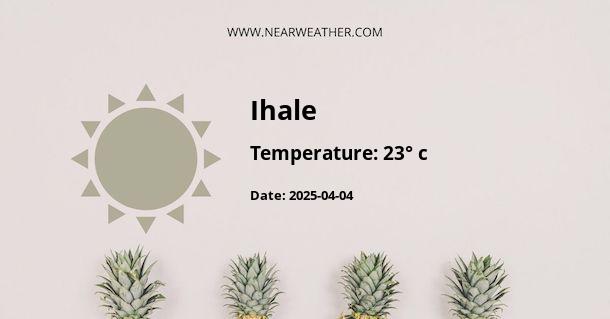Climate and Weather of Ihale, Tanzania
Located in the Ruvuma Region of Tanzania, Ihale is blessed with a tropical climate that offers warm temperatures year-round. This article provides an in-depth analysis of the weather and climate of Ihale and how it influences the region's lifestyle, agriculture, tourism, and overall ecology.
Understanding Ihale's Climate
Ihale, similar to most parts of Tanzania, experiences a tropical savanna climate (Aw) according to the Köppen climate classification. This climate type is characterized by high temperatures throughout the year, with a pronounced dry season.
Ihale's tropical savanna climate is marked by two major seasons: the dry season and the wet season. The dry season typically lasts from June to September, while the wet season spans from October to April.
Temperature Overview
The monthly temperature in Ihale ranges from 20°C to 30°C. The warmest month is typically November, with an average high-temperature of around 30°C. In contrast, the coolest month is usually July, with an average low-temperature of approximately 20°C.
Precipitation Overview
Ihale receives a significant amount of rainfall throughout the year, with the heaviest precipitation typically occurring during the wet season. The region records an average annual rainfall of around 1,000-1,200 mm. The wettest month is usually December, with an average precipitation of 190 mm, while the driest month is typically July, with virtually no rainfall.
Humidity and Wind Speed
Ihale generally experiences high humidity levels due to its tropical savanna climate. The average annual relative humidity is around 75%, with the most humid month being April (80%) and the least humid month being September (70%).
Wind speeds in Ihale are usually moderate, with an annual average of around 3 m/s. The windiest month is typically August, with an average wind speed of 3.5 m/s, while the calmest month is usually February, with an average wind speed of 2.5 m/s.
Climate Impact on Lifestyle and Economy
The tropical savanna climate in Ihale significantly influences the lifestyle and economy of the region. The warm, wet climate is ideal for agriculture, particularly the cultivation of crops such as maize, cassava, and rice. The region's weather also supports the growth of various tropical fruits like mangoes, bananas, and pineapples.
The climate also impacts the region's fauna and flora, making it a biodiversity hotspot that is home to numerous species of birds, mammals, and plants, thereby attracting eco-tourists and researchers.
Summary
In summary, Ihale experiences a tropical savanna climate characterized by high temperatures and significant rainfall throughout the year. The warm, humid conditions support a vibrant agricultural economy and rich biodiversity, making Ihale a unique destination for both locals and visitors.
| Climate Factor | Annual Average | Peak Month |
|---|---|---|
| Temperature | 20°C - 30°C | November (Warmest), July (Coolest) |
| Precipitation | 1,000-1,200 mm | December (Wettest), July (Driest) |
| Humidity | 75% | April (Most Humid), September (Least Humid) |
| Wind Speed | 3 m/s | August (Windiest), February (Calmest) |
While the climate of Ihale can be challenging due to its high temperatures and humidity levels, it is these same factors that contribute to the region's rich agricultural productivity and biodiversity. Despite its challenges, the climate of Ihale offers numerous opportunities for both its inhabitants and visitors.
A - Ihale's Latitude is -2.433330 & Longitude is 32.933331.
A - Weather in Ihale is 19° today.
A - Climate Conditions in Ihale shows few clouds today.
A - Humidity in Ihale is 79% today.
A - Wind speed in Ihale is 11.34 km/h, flowing at 150° wind direction. today.
